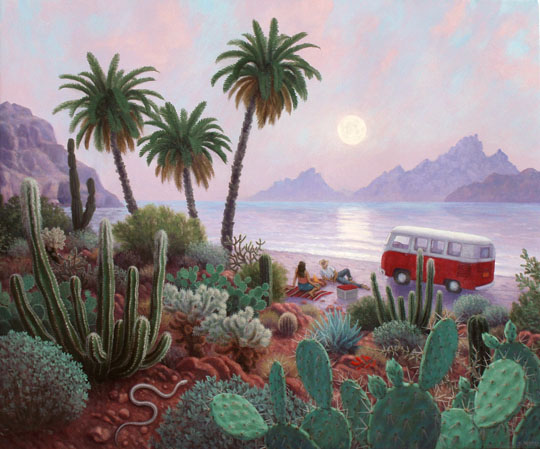By Judy Feldman | www.wildemeyer.com
Summertime is a favorite season to get out of town (especially if you’re in Phoenix) and enjoy the scenery elsewhere. But, sometimes that’s not possible. So, what better way to take a vicarious trip than enjoying a beautiful landscape painting!
There are several wonderful landscape painters at Wilde Meyer. Most are avid outdoors people who love to explore their surroundings in Colorado and New Mexico. Although they all do some studies en plein air, they prefer to take photos and communicate their experiences with larger studio paintings.
Michael Baum said that he and his wife often take road trips in the late afternoon during the summer, “putting on a couple hundred miles, when the light is just right.” She drives, and he takes photos. His painting entitled “Clouds Building” is from one of these trips.
They also take several trips to Utah a year, backpacking and camping in the canyon country. Michael says, “The reality of these places goes beyond what you are seeing. The landscape truly experienced involves all the senses, the subtleties of light reflecting from a canyon wall, the sharp tang of sage in the air, and the coolness of a hidden canyon.”
When he returns to his studio, Michael strives to re-experience his feelings, using his plein air studies and photos. His goal: “to have the viewer experience some of the magic I feel when I’m there.”
I think we can feel the special moment of early morning when we look at “Sunrise on the Bluffs.” And, looking at the cool blues and greens in the beautiful water reflections of “Summer Oasis” makes me forget the summer heat outside! I admire the way Michael has made his mountains recede with muted cool tones, allowing the trees and water to catch the light and sparkle.
Gregory Stocks lives in Salt Lake City, and often paints scenes from the surrounding area. He, too, does small sketches on location and takes reference photos to bring back to his studio. Gregory told me that memory is very important in his work, “as I am able to recall the important aspects of a scene without being bogged down by all of the information that’s not necessary to communicate what I felt in the location at the time.”
His painting entitled “In Harmony” reflects Gregory’s process, and his feelings towards that place along a creek. His beautiful brush strokes and fiery hues tell us that this is a lovely autumn day. The reflection of the sky and trees in the water brings the viewer into the painting, and invites us to stay a while.
Gregory also uses memory to call upon scenes from his youth in the Snake River Valley of Idaho, where he spent his teenage years. “I don’t remember caring so much about the landscape when I was there, but now I’m mining it all up,” he says.
“In a Big Sky” is one of Gregory’s Idaho memory paintings. He says that the winding river and rural scene juxtaposed against the big, colorful sky communicate his emotional response to the area. “I like to refer to a painting like this one as having a sense of ‘breathing room,’ of depth and space and an atmosphere that I can almost feel.”
I think we can agree with that, as well as his wonderful comment that painting is “an emotional vacation that I can take any time.”
Stephen Morath takes a different approach to his paintings. He uses references to places he’s been, but it’s more of a distillation of various landscapes. And, there’s usually a story to tell. For example, “Another Baja Moonrise” shows an unusual image of a desert landscape looking across the Sea of Cortez. But the tall palm trees and the VW bus imply there’s a bigger tale here. According to Stephen, the couple represents Adam and Eve, “totally alone in an exotic landscape.” I guess the snake is another clue. The “hippie vehicle” is something Stephen always wanted!
Since he enjoys painting with cool colors, Stephen likes to portray a scene at the end of the day, or, as with “Morning Moon,” at first sunrise. He commented that his work has an air of “magical realism,” meaning that his attention to details is somewhat unnatural, and his landscapes definitely have a romanticized perspective. The red truck is a wonderful accent against the cool morning desert.
Sometimes, Stephen lets his imagination take over the painting. In his work entitled “Mescalito,” we see what looks like a New Mexican landscape, but there are many characters in this story. I was first drawn to the horseman in the foreground with the cactus face, but then my eyes went everywhere, looking at the images and trying to decipher their meanings. I’ll leave you with that comment. To see more, and come to your own conclusions, it would be best to see the painting at Wilde Meyer!








